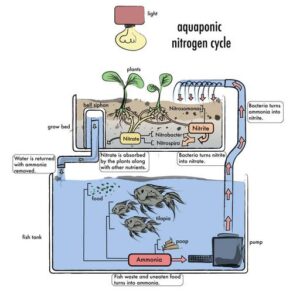Understanding the science behind aquaponics and the natural nitrogen cycle that makes it thrive.

Aquaponics has become one of the most exciting innovations in sustainable farming, combining aquaculture (raising fish) and hydroponics (growing plants in water) into one efficient, symbiotic system. At the heart of aquaponics lies the nitrogen cycle, a natural process that transforms fish waste into valuable nutrients for plants, while plants and bacteria keep the water clean for fish.
This cycle not only reduces waste but also creates a self-sustaining food production system that requires less water and no chemical fertilizers. Let’s break down how this amazing process works step by step.
🐟 Step 1: Fish Produce Ammonia
In the fish tank, species like tilapia are fed daily. As they digest their food, they release waste in the form of poop and uneaten food particles, which decompose into ammonia.
- Ammonia is toxic to fish in high concentrations, so if left untreated, it can harm or even kill them.
- This is where the nitrogen cycle begins to protect the system.
🦠 Step 2: Bacteria Transform Ammonia into Nitrites
Beneficial bacteria play the role of silent heroes in aquaponics.
- Nitrosomonas bacteria colonize the system, particularly in the grow bed media and biofilter.
- These bacteria convert ammonia (NH₃) into nitrite (NO₂⁻).
- While nitrite is less harmful than ammonia, it is still toxic to fish if it builds up.
🦠 Step 3: Bacteria Convert Nitrites into Nitrates
A second type of bacteria takes over:
- Nitrobacter (or Nitrospira) bacteria consume the nitrites.
- They transform nitrites into nitrates (NO₃⁻).
- Unlike ammonia or nitrites, nitrates are safe for fish in moderate amounts and are also one of the most important nutrients for plant growth.
🌱 Step 4: Plants Absorb the Nitrates
The water, now rich in nitrates, flows into the grow bed where plants are rooted.
- Plants absorb nitrates through their roots as fertilizer, helping them grow strong and healthy.
- In addition to nitrates, plants also take up other micronutrients dissolved in the water.
- The grow bed acts as a natural filter, trapping solid waste and cleaning the water.
💧 Step 5: Clean Water Returns to the Fish Tank
After the plants absorb the nutrients, the water is returned to the fish tank.
- By this stage, much of the ammonia has been removed, leaving clean and oxygenated water for the fish.
- The cycle continues indefinitely, as long as fish, plants, and bacteria are balanced.
🔄 Why the Nitrogen Cycle is Essential in Aquaponics
Without the nitrogen cycle, aquaponics would fail. Fish would quickly be poisoned by their own waste, and plants would starve without access to nitrogen in a usable form. The cycle ensures that:
- Fish remain healthy by preventing ammonia buildup.
- Plants receive constant nutrients without chemical fertilizers.
- The system remains balanced and self-sustaining, requiring minimal external input.
🌎 Benefits of the Aquaponic Nitrogen Cycle
- Water Efficiency: Uses up to 90% less water than traditional farming.
- No Chemical Fertilizers: Nutrients come naturally from fish waste.
- Sustainable Food Production: Provides both fish and plants for harvest.
- Environmental Balance: Replicates natural ecosystems where fish, plants, and microbes live in harmony.
🧪 In Summary
The aquaponic nitrogen cycle is a beautiful demonstration of how nature recycles waste into resources. Fish waste becomes ammonia, bacteria transform it into nitrates, and plants use it as food—cleaning the water in the process.
This system not only allows farmers and gardeners to grow fresh vegetables and raise fish simultaneously but also shows us the power of working with nature, rather than against it.